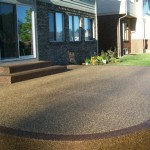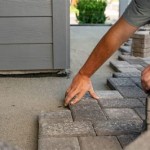Can You Seal Old Concrete Patio? A Comprehensive Guide
Sealing an old concrete patio can significantly extend its lifespan, enhance its aesthetic appeal, and reduce the need for costly repairs. While concrete is a durable material, it is porous and susceptible to damage from weathering, chemicals, and staining. Applying a sealer to an existing concrete patio provides a protective barrier that mitigates these risks. However, successfully sealing old concrete requires careful preparation and the selection of an appropriate sealing product. This article will delve into the process of sealing an old concrete patio, highlighting key considerations, preparation steps, sealer types, and application techniques.
Understanding the Benefits of Sealing Old Concrete
Sealing an old concrete patio offers numerous advantages that contribute to its long-term preservation and enhanced functionality. Unsealed concrete readily absorbs water, leading to freeze-thaw damage in colder climates. When water penetrates the concrete and subsequently freezes, it expands, exerting pressure that can cause cracking and spalling. Sealing the concrete minimizes water absorption, thereby reducing the risk of freeze-thaw damage. Furthermore, a sealer can protect the concrete from stains caused by oil, grease, leaves, and other common patio contaminants. It also serves as a barrier against chemical damage from de-icing salts and fertilizers. Beyond protection, sealing improves the appearance of the patio by enhancing its color and providing a glossy or matte finish, depending on the type of sealer used. This can revitalize the look of an aging patio, making it more visually appealing and easier to clean.
The protective barrier created by a sealant prevents the penetration of many potentially harmful substances. Without a sealant, substances like spilled drinks, motor oil, fertilizers, and even decaying organic matter from leaves can seep into the concrete pores, leading to discoloration and, in some cases, structural damage. The sealant provides a surface that is easier to clean and maintain, requiring less aggressive cleaning methods. Regular sweeping and occasional washing with mild soap and water are often sufficient to keep a sealed patio looking its best. This ease of maintenance translates into long-term cost savings by reducing the need for frequent professional cleaning or repairs.
Moreover, sealing can enhance the structural integrity of the concrete itself. By reducing water absorption, the sealer helps prevent the propagation of existing hairline cracks and minimizes the creation of new ones. This is particularly important for older patios that may already exhibit some degree of cracking or surface deterioration. A good sealant can bind loose particles together and consolidate the surface, making the concrete more resistant to abrasion and impact. The result is a more durable and longer-lasting patio that can withstand heavy foot traffic and outdoor elements.
Preparing the Old Concrete Patio for Sealing
Proper preparation is crucial for a successful concrete sealing project. The condition of the existing concrete surface directly impacts the adhesion and effectiveness of the sealer. Neglecting the preparation phase can lead to premature sealant failure, resulting in peeling, blistering, or discoloration. The preparation process typically involves cleaning, repairing, and profiling the concrete surface.
The first step is thorough cleaning. This involves removing all dirt, debris, oil stains, and loose concrete particles. Sweeping or vacuuming the patio surface is necessary to eliminate loose materials. For stubborn stains, a concrete degreaser or cleaner specifically designed for concrete surfaces should be used. Follow the manufacturer's instructions carefully, and thoroughly rinse the patio with clean water after applying the cleaning solution. Pressure washing can be an effective method for removing dirt and algae, but it is essential to use a pressure setting that doesn't damage the concrete surface. A wide fan nozzle and a moderate pressure setting are generally recommended. Allow the concrete to dry completely before proceeding to the next step.
After cleaning, inspect the patio for any cracks or damage. Small hairline cracks can often be filled with a concrete crack filler compound. Larger cracks may require more extensive repairs, such as patching with a concrete repair mortar. Follow the manufacturer's instructions for applying these repair materials, and allow them to cure completely before proceeding. If the patio has significant spalling or surface deterioration, consider consulting a concrete repair professional to assess the extent of the damage and recommend appropriate repair solutions.
Profiling the concrete surface is often necessary to improve the adhesion of the sealer. Concrete sealers adhere best to a slightly porous surface. If the existing concrete is very smooth or has a glazed finish, it may need to be mechanically profiled. This can be achieved through methods such as acid etching or grinding. Acid etching involves applying a diluted solution of muriatic acid to the concrete surface. This creates a slightly rough texture that enhances sealer adhesion. Always wear appropriate protective gear, including gloves and eye protection, when working with acid. Grinding, using a concrete grinder with a diamond grinding wheel, can achieve a similar result. Choose the method that is best suited for the type of concrete and the desired level of profiling.
Selecting the Right Concrete Sealer
The type of concrete sealer used plays a critical role in the longevity and performance of the sealed patio. There are various types of sealers available, each with its own properties and suitability for different applications. The selection process should consider factors such as the climate, the intended use of the patio, and the desired aesthetic appearance.
Acrylic sealers are a popular choice for concrete patios due to their ease of application and relatively low cost. They provide a good level of protection against water and stains and are available in both water-based and solvent-based formulations. Water-based acrylic sealers are generally considered more environmentally friendly and easier to clean up, while solvent-based acrylic sealers offer slightly better durability and resistance to chemicals. Acrylic sealers typically provide a glossy or semi-gloss finish, enhancing the color of the concrete and giving it a wet look.
Epoxy sealers are known for their exceptional durability and resistance to chemicals and abrasion. They form a hard, protective coating that is ideal for high-traffic areas or patios that are exposed to harsh chemicals. Epoxy sealers are typically two-part systems that require mixing before application. They offer excellent adhesion to concrete and provide a smooth, even finish. However, epoxy sealers can be more challenging to apply than acrylic sealers and may require professional installation.
Penetrating sealers, such as silane or siloxane sealers, work by penetrating the concrete surface and reacting with the cement to create a hydrophobic barrier. These sealers do not form a surface film and do not alter the appearance of the concrete. They are highly effective at preventing water absorption and protecting against freeze-thaw damage. Penetrating sealers are a good choice for patios where a natural look is desired or where a surface film sealer is not suitable.
Polyurethane sealers offer a combination of durability, chemical resistance, and UV resistance. They are often used as a topcoat over epoxy sealers to provide enhanced protection and a glossy finish. Polyurethane sealers are available in both water-based and solvent-based formulations. They are a good choice for patios that are exposed to sunlight and chemicals, such as those near swimming pools or outdoor kitchens.
Applying the Concrete Sealer
Proper application of the concrete sealer is essential for achieving a durable and aesthetically pleasing finish. The application process typically involves applying one or more coats of sealer to the prepared concrete surface, following the manufacturer's instructions carefully.
Before applying the sealer, ensure that the concrete surface is completely dry. Moisture trapped beneath the sealer can lead to blistering or peeling. Check the weather forecast to ensure that there is no rain expected for at least 24 hours after application. The ideal temperature for applying concrete sealer is typically between 50°F and 80°F. Avoid applying sealer in direct sunlight or during periods of high humidity.
The sealer can be applied using a paint roller, a brush, or a sprayer. A paint roller is a good choice for applying sealer to large, flat surfaces. Use a high-quality roller with a nap that is appropriate for the type of sealer being used. A brush is useful for applying sealer to edges, corners, and other areas that are difficult to reach with a roller. A sprayer can be used to apply sealer quickly and evenly over large areas. However, spraying requires careful masking to protect surrounding surfaces from overspray.
Apply the sealer in thin, even coats. Avoid applying too much sealer in one coat, as this can lead to runs, drips, or uneven drying. Allow each coat of sealer to dry completely before applying the next coat. The drying time will vary depending on the type of sealer, the temperature, and the humidity. Follow the manufacturer's instructions for the recommended drying time between coats.
After applying the final coat of sealer, allow the patio to cure completely before allowing foot traffic or placing furniture on the surface. The curing time will vary depending on the type of sealer and the environmental conditions. Follow the manufacturer's instructions for the recommended curing time. Once the sealer has fully cured, the patio is ready for use. Regular cleaning and maintenance will help to prolong the life of the sealed surface.

Concrete Stain And Sealer Patio Makeover Exchange

How To Apply Sealer New And Old Concrete

How To Paint And Seal Your Concrete Driveway Like New Pro Diy

How To Seal A Concrete Patio Once U C Coatings

How To Re Faded Stamped Concrete Direct Colors

Preparing Old Sealed Concrete For Stain Or Paint Brad The Painter

Stamp Concrete Patio Restoration Sealing The Paver Sealer

Penetrating Vs Surface Concrete Sealers Which Is Best

How To Clean Seal Your Concrete Patio

Best Patio Sealer Concrete Paving
Related Posts








